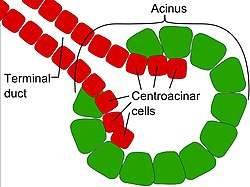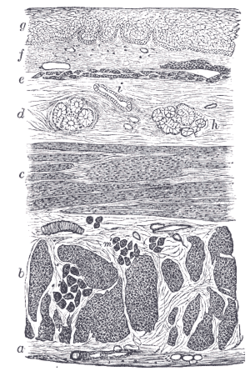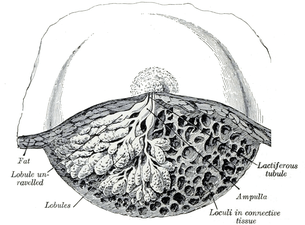Exocrine gland
Exocrine glands are glands that secrete substances onto an epithelial surface by way of a duct.[1] Examples of exocrine glands include sweat, salivary, mammary, ceruminous, lacrimal, sebaceous, and mucous. Exocrine glands are one of two types of glands in the human body, the other being endocrine glands, which secrete their products directly into the bloodstream. The liver and pancreas are both exocrine and endocrine glands; they are exocrine glands because they secrete products—bile and pancreatic juice—into the gastrointestinal tract through a series of ducts, and endocrine because they secrete other substances directly into the bloodstream.
| Exocrine gland | |
|---|---|
 | |
| Details | |
| Identifiers | |
| Latin | glandula exocrina |
| MeSH | D005088 |
| TH | H2.00.02.0.03014 |
| FMA | 9596 |
| Anatomical terminology | |
Classification
Structure
Exocrine glands contain a glandular portion and a duct portion, the structures of which can be used to classify the gland.[1]
Method of secretion
Exocrine glands are named apocrine glands, holocrine glands, or merocrine glands based on how their products are secreted.[1]
- Merocrine secretion – cells excrete their substances by exocytosis; for example, pancreatic acinar cells.
- Apocrine secretion – a portion of the cell membrane that contains the excretion buds off.
- Holocrine secretion – the entire cell disintegrates to excrete its substance; for example, sebaceous glands of the skin and nose.
Product secreted
- Serous cells secrete proteins, often enzymes. Examples include gastric chief cells and Paneth cells
- Mucous cells secrete mucus. Examples include Brunner's glands, esophageal glands, and pyloric glands
- Mixed glands secrete both protein and mucus. Examples include the salivary glands: although the parotid gland 20%is predominantly serous, the sublingual gland 5% mainly mucous gland, and the submandibular gland 70%is a mixed, mainly serous gland.
- Sebaceous glands secrete Sebum, a lipid product. These glands are also known as oil glands, e.g. Fordyce spots and Meibomian glands.
Additional images
 Section of the human esophagus.
Section of the human esophagus. Dissection of a lactating breast.
Dissection of a lactating breast.
See also
References
- Young, Barbara; O'Dowd, Geraldine; Woodford, Phillip (2013). Wheater's Functional Histology: A Text and Colour Atlas (Sixth ed.). Elsevier. p. 95. ISBN 978-0702047473. LCCN 2013036824.